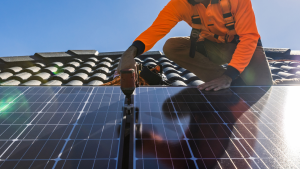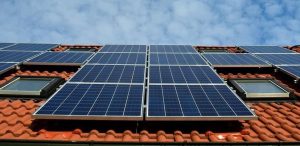When it comes to making your home more comfortable, efficient and future-ready, retrofitting your home is one of the smartest investments you can make. But what does “retrofit” actually mean? In simple terms, it’s about upgrading existing homes to make them warmer, greener and cheaper to run – and it’s becoming an increasingly important part of the UK’s path to net zero.
Retrofitting involves upgrading an existing home with modern energy-saving or low-carbon technologies. That could include:
- Better insulation (walls, loft, floor)
- Upgraded windows or doors
- Draught proofing and sealing gaps
- More efficient heating systems (e.g. heat pumps)
- Renewable energy sources like solar PV and battery storage
- Smart heating controls and ventilation
It’s not about building new, it’s about bringing existing homes up to date.
At SWH Electrical Solutions, we help homeowners and landlords across the North East make energy-saving improvements that genuinely make a difference, from solar panels and battery storage to air source heat pumps and electrical upgrades. Whether your goal is to lower bills, reduce your carbon footprint or simply add long-term value to your property, retrofitting your home can tick every box.
So, why retrofit your home?
1. Lower energy bills
With energy prices still unpredictable, improving your home’s efficiency can have a huge impact on your monthly costs. Retrofitting your home with renewable technologies such as solar panels and battery storage means you can generate and use more of your own clean energy rather than buying it from the grid. Over time, that translates to serious savings.
2. A warmer, more comfortable home
Older homes are notorious for draughts, cold spots and poor insulation. Retrofitting enables you to tackle these issues head-on, improving insulation, upgrading heating systems and integrating smart controls that keep rooms at a consistent, comfortable temperature all year round.
3. Reducing your carbon footprint
Every improvement you make to your home’s efficiency reduces the amount of energy wasted and, with that, your carbon emissions. Installing renewables like solar panels or a heat pump is a big step toward living more sustainably, helping you do your bit for the planet while saving money in the process.
4. Protecting your home’s future value
Research from Scottish Power and WWF found that:
- An air-source heat pump could boost a home’s value by £5,000 – £8,000
- Solar panels could add around £1,350 – £5,400 to the sale price
- An electric vehicle charge point could improve value by around £5,000
When these energy efficiency improvements are combined, retrofitting could increase the value of a home by an average of £10,000.
Investing in retrofit improvements now can enhance your home’s future value and protect you against changing regulations and rising expectations.
5. Improving property appeal for landlords
For landlords, retrofitting is no longer just a nice-to-have; it has become a necessity. Tenants are increasingly aware of energy efficiency, and properties with strong EPC ratings are more attractive to potential renters. Retrofitting can also help avoid future compliance issues as minimum energy standards evolve.

Why retrofitting has become such a hot topic
The UK has one of the oldest and least energy-efficient housing stocks in Europe, and around 80% of the homes that will exist in 2050 have already been built. That means retrofitting is essential if the country is to meet its net-zero goals.
While retrofitting commercial buildings is now a fairly common practice, the challenge lies in applying those same principles to residential homes, where each property is different and upgrades often need to be tailored to suit the existing structures and budgets.
At SWH, we understand the balance between what’s ideal and what’s practical. We’ve supported countless homeowners and landlords with renewable installations that deliver real results, helping them take achievable steps toward a more energy-efficient home.
Where SWH comes in
We’re experienced in supporting home retrofit projects and understand the frameworks, reporting and paperwork that go hand in hand with energy efficiency upgrades.
Our team can advise on the best renewable and electrical improvements for your property, whether that’s a complete solar and battery system, an air source heat pump or upgraded wiring and lighting to make your home safer and more efficient.
We work in line with TrustMark and Microgeneration Certification Scheme (MCS) standards to ensure every installation meets recognised quality and performance benchmarks. That means your system will not only deliver reliable savings but also meet the requirements for many funding and incentive schemes.
We also work closely with other contractors and energy consultants, so if retrofitting is part of a larger project, we can fit seamlessly into the process and ensure everything runs smoothly from start to finish.
Ready to take the next step?
If you’re ready to make your home warmer, greener and more energy-efficient, we can help. From design and installation to support and maintenance, SWH Electrical Solutions is your trusted partner for renewable and electrical upgrades across the North East.
Get in touch to learn more about how we can help with retrofitting your home for a brighter, more efficient future.
Retrofit FAQs
What does “retrofit” actually mean?
Retrofit simply means upgrading an existing property to improve its energy efficiency, comfort and performance. This could include adding solar panels, replacing old heating systems with renewable alternatives like heat pumps, upgrading insulation or improving electrical systems. It’s about working with what you’ve got, not starting from scratch, to make your home more sustainable.
Is retrofitting the same as renovating?
Not quite. Renovation focuses on updating the look or condition of a property – think new kitchens, bathrooms or decor. Retrofitting, on the other hand, is about improving the efficiency and functionality of your home. You can, of course, do both together – in fact, combining renovation with retrofit upgrades often makes perfect sense.
Do I need planning permission to retrofit my home?
Most energy-efficiency upgrades, like solar panels or heat pumps, fall under Permitted Development Rights (PDR) in the UK, meaning you usually won’t need planning permission. However, there are exceptions for listed buildings, conservation areas or certain property types, so it’s always worth checking with your local planning authority first.
Is retrofitting only for older homes?
Not at all. While older properties often benefit the most, even newer homes can be made more efficient. A retrofit approach can reduce running costs, incorporate renewable technology or bring your property up to modern standards for comfort and sustainability.
What kind of upgrades make the biggest impact?
It depends on your home, but some of the most effective retrofit measures include:
- Installing solar panels and battery storage
- Upgrading to an air source heat pump
- Improving insulation and draft-proofing
- Switching to LED lighting and smart controls
Each of these steps helps reduce your energy bills and carbon footprint while improving comfort year-round.
Can SWH help if I’m not sure where to start?
Absolutely. SWH can help you assess your current setup and suggest the best retrofit options for your home or rental property. Whether you’re ready to install solar panels or simply exploring how to make your home more efficient, we’ll guide you through your options and recommend trusted contractors for any work we can’t carry out ourselves.
Can SWH work on retrofit projects that they didn’t originally install?
Yes – we regularly work on systems installed by other contractors. Whether you need maintenance, upgrades or advice on adding new renewable technologies, we can step in to help you get the most out of your existing setup.
How much does retrofitting cost?
The cost varies depending on the size of your home and the measures you choose to install. However, the long-term savings on energy bills, combined with government incentives for renewable technologies, mean most homeowners see a strong return on investment. We’ll always provide a clear, tailored quote before starting any work.





